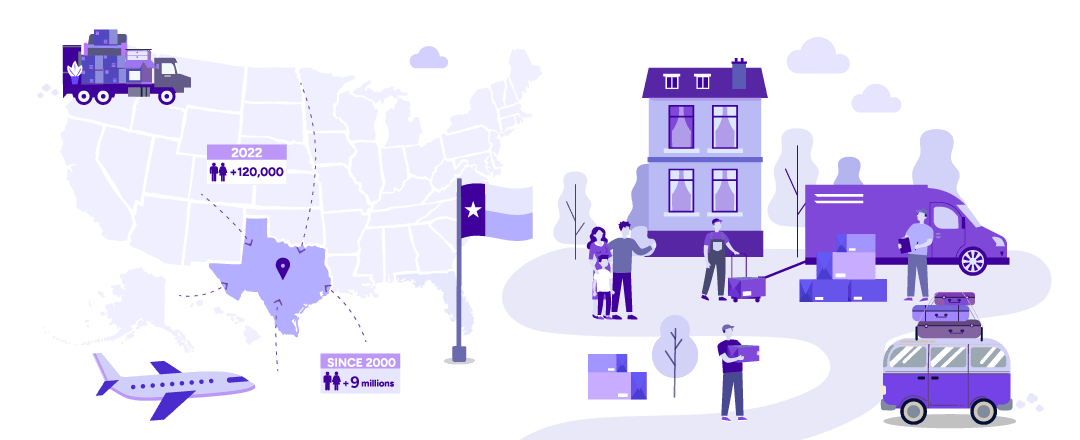Moving to Texas from Florida? Here's What to Expect
Relocating from Florida to Texas is a journey filled with excitement, opportunities, and new beginnings. With its diverse climate, thriving job market, and cultural richness, Texas welcomes newcomers with open arms. Whether you’re drawn to the rolling hills of Austin or the bustling streets of Houston, Texas has a place for you to call home.
From Humid Sunshine to Dry Heat
Florida’s tropical climate is known for its high humidity, frequent afternoon thunderstorms, and mild winters. On the other hand, Texas offers diverse climate zones, ranging from humid subtropical regions in the east to arid deserts in the west.
Temperature Ranges
Summers in Florida and Texas can both get sweltering, with highs often reaching the mid-90s Fahrenheit. However, Texas’s dry heat, particularly in the central and western regions, feels less oppressive compared to Florida’s high humidity.
Seasonal Weather Patterns
Florida sees more frequent rainfall and hurricanes, while Texas experiences a mix of severe thunderstorms, tornadoes in the Panhandle, occasional hurricanes along the Gulf Coast, and milder winters overall. For winter wonderland enthusiasts, North Texas even offers the occasional snow day!
Florida | Texas | |
State Nickname | Sunshine State | Lone Star State |
Population (2023) | ~22 million | ~30 million |
Capital City | Tallahassee | Austin |
Largest City | Jacksonville | Houston |
Size (Area) | 65,758 sq. miles | 268,596 sq. miles |
Economy (GDP) | ~$1.3 trillion | ~$2.4 trillion |
Famous for | Beaches, theme parks, space launches | BBQ, live music, NASA, and rodeos |
Environmental Factors: Air Quality and Natural Disasters
Air Quality
Texas generally has better air quality compared to Florida, especially in rural and suburban areas. Efforts to increase renewable energy usage, like wind and solar, further improve Texas’s environmental standing.
Natural Disaster Risks
While Florida’s hurricanes are infamous, Texas has its own challenges with tornadoes in the Panhandle and flooding in low-lying regions. However, Texas’s size offers regions with lower disaster risks, such as the Hill Country.
Conservation Efforts
Texas is a leader in renewable energy, being the top state for wind power production. Moving to Texas could align with your environmentally-conscious values, thanks to its investment in sustainable energy.
Cost of Living: Saving More in Texas
Moving to Texas often translates to lower living costs. Texas offers more affordable home prices and rental rates compared to many Florida cities. For instance, the median home price in Dallas is around $320,000, compared to Miami’s $500,000.
Texas also tends to have slightly lower grocery prices due to reduced transportation costs and competitive markets. And when it comes to utilities, electricity prices in Texas are often lower, thanks to deregulated markets and the availability of renewable energy sources.
Affordable and Diverse Housing Options
Texas boasts a robust and varied housing market. The state’s median home price is approximately $290,000, significantly lower than Florida’s median of $365,000. Renting is also more affordable in Texas. For example, a two-bedroom apartment in Austin averages $1,800 per month, compared to $2,500 in Miami.
While Texas has no state income tax, property taxes can be higher. However, the savings from other areas often offset this expense.
Big Savings on Taxes in Texas
One of the biggest financial perks of moving to Texas is its tax structure. Both states have no state income tax, but, Texas residents often enjoy lower overall tax burdens due to competitive sales tax rates. Texas’s property tax averages 1.8%, compared to Florida’s 0.9%. This difference is often balanced by lower housing costs in Texas. And Texas’s sales tax rate ranges from 6.25% to 8.25%, comparable to Florida’s 6% to 8.5%.
A Booming Job Market
The unemployment rate in Texas is consistently low, with significant job growth in urban centers. Texas is a hub for industries ranging from technology to energy. Key sectors include energy, healthcare, technology, agriculture, and manufacturing. Cities like Austin are tech powerhouses, while Houston excels in energy. Average salaries in Texas align closely with Florida, but the lower cost of living provides greater purchasing power.
Quality Schools and Universities
Florida’s public schools are competitive, but Texas’s focus on STEM education and diverse programs stands out. The Lone Star State is home to highly-rated school districts, such as Eanes ISD in Austin and Highland Park ISD in Dallas. Meanwhile, prestigious institutions like Baylor University, the University of Texas, Texas A&M, and Rice University attract students from across the nation.
Expansive and Accessible Healthcare
Healthcare options in Texas are abundant. Texas Medical Center in Houston is the world’s largest medical complex. Throughout the state, you can find high-quality care, though rural areas may have fewer options compared to urban centers.
Transportation in Texas
Average commutes in Texas are comparable to Florida, though sprawling urban areas may require longer travel times. Texas cities are known for traffic congestion, but efficient highway systems and commuter options are expanding and improving. Cities like Dallas and Houston offer light rail systems, while smaller cities may rely more on buses.
Affordable and Diverse Utilities and Energy Sources
Texas’s energy landscape is a standout. Texas is the nationwide leader in renewable energy, particularly wind and solar power. Also, thanks to its deregulated energy markets, Texans often enjoy lower electricity rates compared to Floridians. And embracing green energy is easier and often cheaper in Texas.
Finding Secure Neighborhoods
Safety varies by city and neighborhood. Texas cities like Plano and Frisco boast low crime rates, comparable to Florida’s safest areas. When considering a move, be sure to research local crime data and community reviews to find the best fit for your family.
Local Regulations and Laws
Texas vehicle registration fees are slightly higher but include emissions testing in urban areas. Meanwhile, Texas’s pro-business policies encourage entrepreneurship and investment.
Endless Entertainment
Texas offers a wealth of cultural venues, from Austin’s live music scene to Houston’s theater district. You can even explore the Alamo in San Antonio or attend the Houston Rodeo!
Nature Awaits
With fewer muggy days in many parts of Texas, outdoor activities like hiking, cycling, and exploring the state’s stunning parks are often more comfortable. Texas boasts over 80 state parks, offering hiking, camping, and fishing opportunities. And while Florida’s beaches are iconic, Texas’s Gulf Coast and Hill Country offer beautiful scenic alternatives.
A Culinary Adventure
Texas offers world-famous barbecue, Tex-Mex, and even Eastern European-inspired diverse international dining options. And you’ll find cities like Austin and Houston to be foodie paradises, with restaurants for every palate.
Political Climate
The politics of Florida reflect a state that has experienced conflict between its more liberal southern region and its traditionally conservative northern region. Texas’s political diversity also mirrors its cultural diversity, with communities holding a mix of conservative and progressive values. But in Texas, you’ll find a high priority placed on local governance, giving communities a strong voice in decision-making.
Making a Strategic Move
The average cost of an interstate move ranges from $4,000 to $8,000, depending on distance and volume of things you’re bringing along. Spring and fall are ideal for moving, with milder weather and fewer disruptions from school schedules or holidays. Be sure to plan your move during the offseason for better rates on moving services and less traffic congestion.
When you’re ready to find a new home, Texas has an abundance of experienced real estate agents to guide your home search. And from national brands to local options, you’ll find plenty of reliable movers.

Comparing Cities: Florida vs. Texas
Austin vs. Jacksonville
Population: Austin has around 1 million residents, while Jacksonville has around 950,000.
Cost of Living: Austin’s tech hub offers higher salaries but a slightly higher cost of living.
Lifestyle: Both cities balance urban amenities with outdoor activities.
Dallas vs. Tampa
Population: Dallas sits around 1.3 million folks vs. Tampa’s 400,000.
Cost of Living: Dallas is more affordable for housing, while Tampa offers a coastal vibe.
Houston vs. Miami
Population: Houston boasts around 2.3 million while Miami has around 470,000.
Cost of Living: Houston is significantly more affordable.
San Antonio vs. Orlando
Population: San Antonio has 1.5 million residents vs. Orlando’s 300,000.
Lifestyle: San Antonio’s rich and diverse history contrasts with Orlando’s theme park focus.
Fort Worth vs. Fort Lauderdale
Population: Fort Worth is home to around 950,000 vs. Fort Lauderdale’s 180,000.
Cost of Living: Fort Worth offers lower housing costs and a more laid-back vibe.
When You Get to Texas, Get in Touch!
Moving from Florida to Texas is a rewarding decision packed with opportunities for growth and savings – including the chance to compare electricity plans from different providers, and choose the one that best suits your lifestyle and your budget.
Sign up with Rhythm Energy today!




